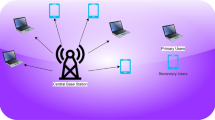Abstract
An opportunistic network is a wireless ad hoc network that has frequently intermittent connectivity due to nodes’ mobility. These spare, unpredictable networks aim to solve the prolonged delay paths by a store-carry-forward scheme. It is difficult to determine the appropriate nodes to forward the messages since there are few opportunistic contacts. The nodes might decide based on the obtained data of the network as a guide to reach a destination. The aforementioned technique is not helpful in case the rate of change in the network topology is higher than the rate of data gathering due to usage restrictions and uncertain available information/knowledge of the future contacts. In this paper, to cope with the challenges imposed by the un-deterministic environment, a risk assessment strategy is considered to evaluate the short and long-term impact of each decision to find the optimal node/paths. This routing scheme can take advantage of the unanticipated connection to make the routing more flexible in short time and with less buffer usage. Our proposed risk assessment algorithms that are based on MALP are mixed with the knowledge about buffer management and network capacity. The prioritized messages to be disseminated as well as better decision to take a risk are the main contributions of this paper. Moreover, the self-adaptive threshold, distributed PID controller, is considered to tackle different threshold levels for each node individually. Numerical results prove that the proposed method drastically increases the delivery ratio and also minimizes the risk of exceeding resource consumption and packet loss.




















Similar content being viewed by others
References
Huang CM, Lan CM, Tsai CZ (2008) A survey of opportunistic networks. In: Proceedings of the 22nd International Conference on Advanced Information Networking and Applications, IEEE Computer Society, Washington, DC, pp 1672–1677
Khabbaz MJ, Assi CM, Fawaz WF (2012) Disruption-tolerant networking: a comprehensive survey on recent developments and persisting challenges. IEEE Commun Surv Tutor 14(2):607–640
Cuka M, Elmazi D, Oda T, Kulla E, Ikeda M, Barolli L (2017) A fuzzy-based system for selection of IoT devices in opportunistic networks considering IoT device speed, storage and remaining energy parameters. In: International Conference on Intelligent Networking and Collaborative Systems, pp 16–27
Wu Y, Deng S, Huang H (2013) Optimal management of dynamic information in delay tolerant networks. J Supercomput 66(1):320–338
Arastouie N, Sabaei M (2016) Data forwarding scheme to minimize end-to-end delay in opportunistic networks. In: 8th International Symposium on Telecommunications (IST), 2016, Tehran, pp 27–28. https://doi.org/10.1109/ISTEL.2016.7881770
Lindgren A, Doria A, Schelèn O (2003) Probabilistic routing in intermittently connected networks. Mob Comput Commun Rev 7(3):239–254
Ukey N, Kulkarni L (2017) Energy based recent trends in delay tolerant networks. In: Lecture Notes in Networks and Systems book series (LNNS), vol 9. pp 141–150
Al-Hinai A, Zhang H (2014) TB-SnW: trust-based spray-and-wait routing for delay-tolerant networks. J Supercomput 69(2):593–609
Kumar A, Dhurandher SK, Woungang I, Obaidat MS, Gupta S, Rodrigues JPC (2017) An altruism-based trust-dependent message forwarding protocol for opportunistic networks. Int J Commun Syst. https://doi.org/10.1002/dac.3232
Burns B, Brock O, Levine BN (2005) MV routing and capacity building in disruption tolerant networks. In: Proceedings of the IEEE INFOCOM 2005, Miami, FL
Mamoun MH, Barrak SE (2013) Proposed fuzzy based routing for DTN. Int J Comput Appl 66(6):0975–8887
Nabhani P, Bidgoli AM (2012) Adaptive fuzzy routing in opportunistic network. Int J Comput Appl 52(18):7–11
Bocquillon R, Jougleta A (2018) Robust routing in deterministic delay-tolerant networks. Comput Oper Res 92:77–86
Burgess J, Gallagher B, Jensen D, Levine BN (2006) MaxProp: routing for vehicle-based disruption-tolerant networks. In: Proceedings of the 25th IEEE International Conference on Computer Communications (INFOCOM 06), pp 1–11
Malik N, Gupta S, Bhushan B (2015) A fuzzy based routing protocol for delay tolerant network. Int J Grid Distrib Comput 8(1):11–24
Nabhani P, Radmanesh S (2012) Adaptive fuzzy routing in opportunistic network. Int J Comput Electr Autom Control Inf Eng 6(11):1326–1330
Jain S, Chawla M, Soare VNGJ, Rodrigues J (2014) Enhanced fuzzy logic-based spray and wait routing protocol for delay tolerant networks. Int J Commun Syst 29(12):1820–1843
Lloyd JW (1987) Foundations of logic programming, 2nd edn. Springer, Berlin
Medina J, Ojeda-Aciego M, Vojtáš P (2004) Similarity-based unification: a multi-adjoint approach. Fuzzy Sets Syst 146:43–62
Juli’an P, Moreno G, Penabad J (2006) Operational/Interpretive unfolding of multi-adjoint logic programs. J Univ Comput Sci 12(11):1679–1699
Fuzzy LOgic Programming Environment for Research (FLOPER). http://dectau.uclm.es/floper/. Accessed 7 May 2017
Åström KJ, Murray RM (2008) Feedback systems: an introduction for scientists and engineers. Princeton University Press, Princeton
Abdelkader T, Naik K, Nayak A, Goel N, Srivastava V (2016) A performance comparison of delay tolerant network routing protocols. IEEE Netw 30(2):46–53
Keranen A (2008) Opportunistic network environment simulator. Special Assignment report from Department of Communications and Networking, Helsinki University of Technology
Chaintreau A, Hui P, Croecroft J, Diot C, Gass R, Scott J (2007) Impact of Human Mobility on Opportunistic Forwading Algorithms. IEEE Trans Mob Comput 6(6):606–620
Author information
Authors and Affiliations
Corresponding author
Rights and permissions
About this article
Cite this article
Arastouie, N., Sabaei, M. Self-adaptive risk-aware routing in opportunistic network. J Supercomput 74, 2385–2411 (2018). https://doi.org/10.1007/s11227-018-2264-2
Published:
Issue Date:
DOI: https://doi.org/10.1007/s11227-018-2264-2




